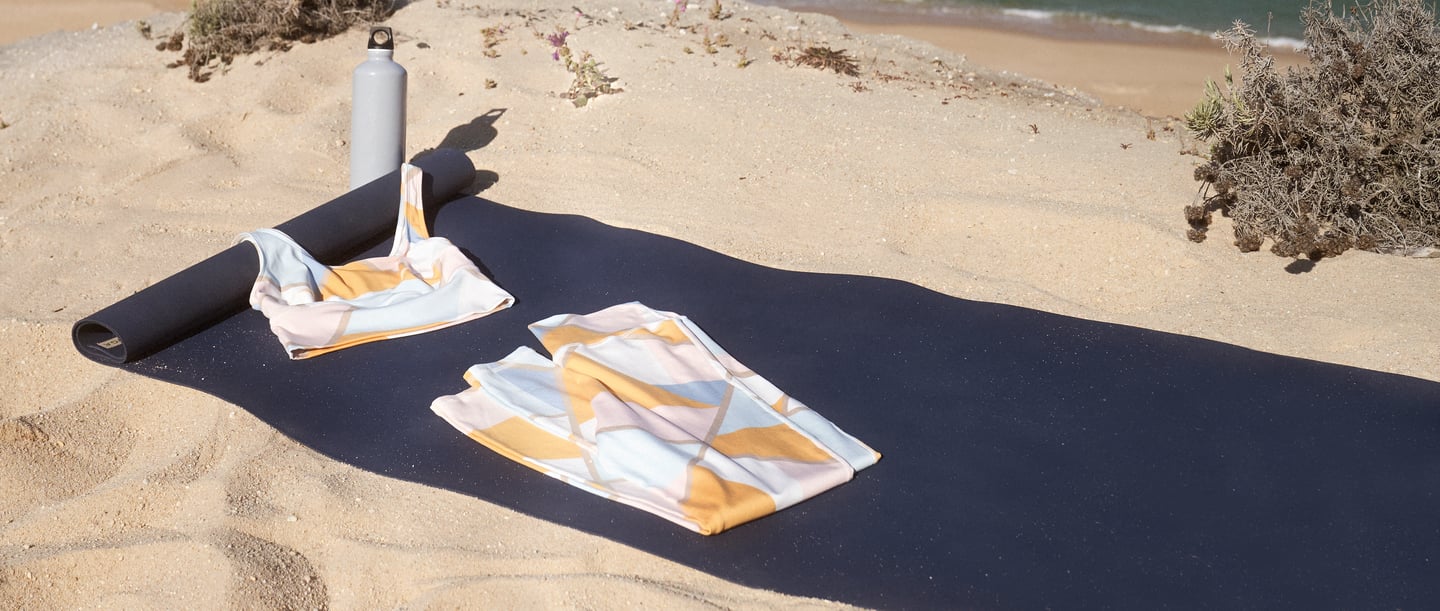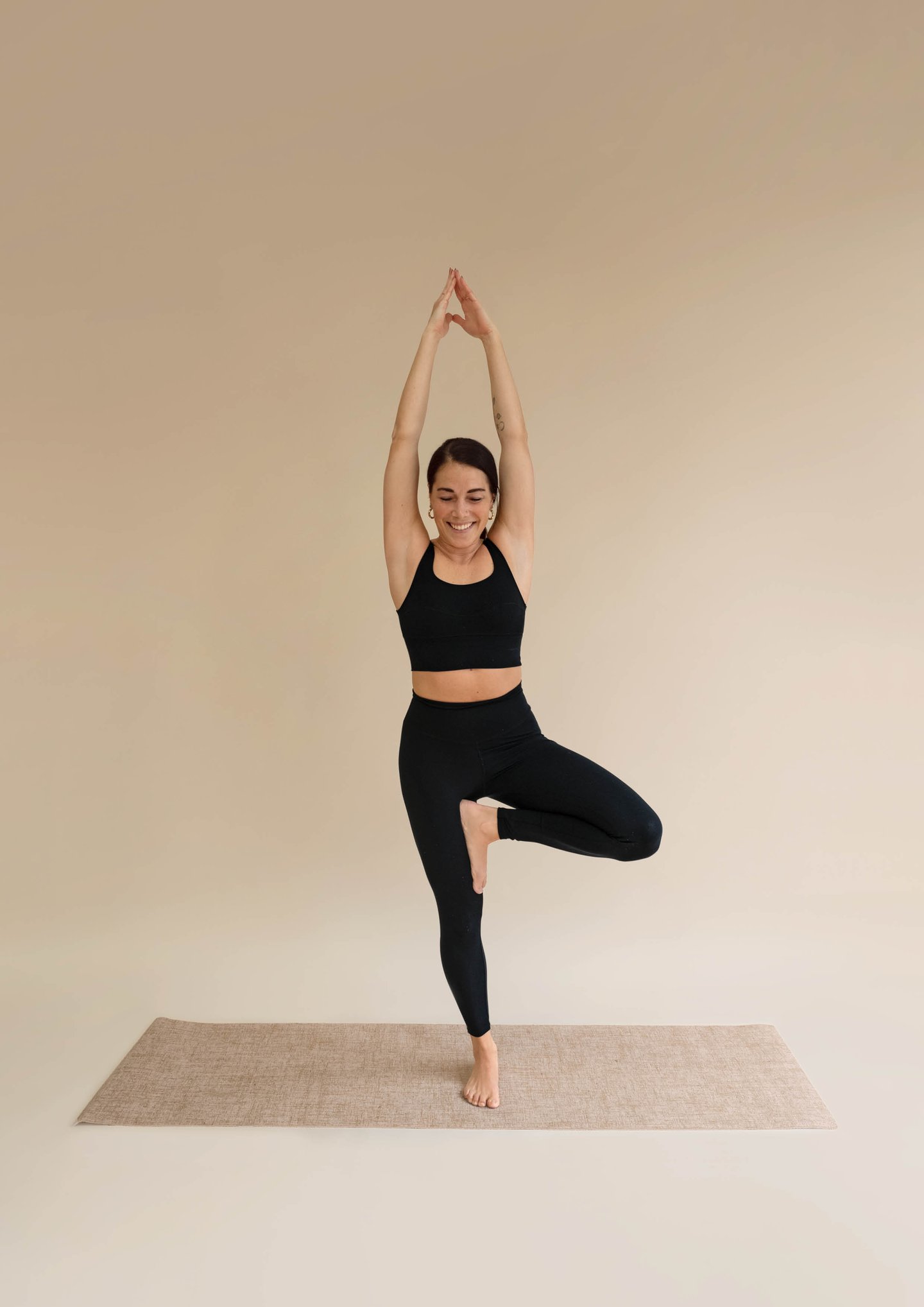Yoga for beginners: bring more balance to your life
At one with yourself and the world. Relaxed, destressed and in touch with your inner self. Anyone who has ever tried yoga will understand how these positive associations with this popular physical activity evolved as it spread throughout the world from India many thousands of years ago. In this post, CALIDA sets out to explain what it is that makes yoga so unique and provide tips as to the best way for beginners to take up yoga. Try our six easy exercises at home!
5 May 2023 • 10 min reading time

Find your inner peace and strengthen your body.
It is still not entirely clear when exactly yoga was first practised. While some researchers suspect it originated around 3,000 years ago, other sources suggest that elements of yoga existed as early as 5,000 years ago. Although questions remain as to the date of origin of this popular physical activity, its birthplace is undoubtedly India.
Many people are unaware that yoga is much more than just a popular physical activity that is supposed to help us relax. Yoga is actually a philosophical teaching based on a total of eight ‘limbs’ called yama, niyama, asana, pranayama, pratyahara, dharana, dhyana and samadhi; so yoga as a whole is more of a spiritual outlook on life, thanks to its extensive rules, wisdom and codes.
As well as the traditional poses, so-called asanas, yoga also involves meditation, discipline, various etiquettes, physical cleansing, nutrition and training the senses. Today, we are focusing on physical Hatha yoga, which includes asanas along with elements of meditation and pranayama (breathing exercises).
The ways in which you can learn yoga are just as diverse as the different types. Of course, you can book a retreat in India in order to deeply immerse yourself in the world of yoga and experience its spiritual teachings at first hand.
If you simply want to bring a little more balance to your life, however, and improve your stamina, strength, flexibility or health, you can just as well learn the basics of meditation and the main asanas at your local gym or in your own home. Below, we will present six simple yoga exercises for beginners.

You can practise yoga alone or with a group of people. Chelsey and Sany are wearing the bustiers from the series "Natural Skin" and "Circular Relax".
For improved comfort, casual sportswear consisting of a top and yoga leggings is beneficial, along with a yoga mat. You don’t need special footwear, as you usually do yoga barefoot, in order to fully ground yourself. If you want, you can also buy a yoga block for some asanas; but this is totally optional!
In addition to a comfortable mat and appropriate clothing, one other thing is particularly important for yoga: the right atmosphere. As Hatha yoga consists of meditation and conscious breathing, in addition to asanas, the setting should be as peaceful and relaxed as possible. If you want to do yoga at home, you can dim the lights, for example, light your favourite scented candle or open the window to listen to the birds and the wind.
Discover our yoga sets here:
Have you created a cosy atmosphere, rolled out your mat and donned your yoga outfit? Then you can now start your first exercises. As yoga usually begins with stretching exercises before moving on to toning and then resting and/or final poses, we also want to give you a useful sequence of different asanas for beginners.
The Cobra pose (Bhujangasana) is a traditional asana to strengthen your spine, stretch your abdominal muscles, open your chest and boost your strength for the next asana. There is a difference between the Baby and King Cobra.
To start both exercises, lie down on your stomach with the tops of your feet on the ground and place your hands close to your body, directly under your shoulders with your fingers facing forwards. Now straighten your torso, while pushing your chest forward and bringing your shoulder blades together.
From this position, the Baby Cobra, transition to the King Cobra, by lifting your pelvis from the floor. Your entire weight is now resting on your feet and arms. Hold this pose, take a few controlled breaths and slowly lower yourself back down to your starting position.
There are three different versions of the Warrior pose (Virabhadrasana) in yoga that are primarily intended to strengthen your lower body; Warrior III is fairly challenging and therefore not included in our yoga exercises for complete beginners. Warrior I relaxes your legs and buttocks, as well as your shoulders and neck, while mobilising your chest and hips.
To get into position for the Warrior I asana, stand up straight and/or adopt the Mountain pose (Tadasana). Now make a wide lunge of around 1.30 to 1.50 metres with your right leg. As your left leg straightens out, bend your right knee directly over your right ankle so that your thigh is parallel to the floor. Your knee should not move beyond your toes.
Now raise your arms and bring your palms together. Rotate your torso backwards to slightly arch your back. Throughout this exercise, make sure that your body remains straight and that your hips are facing forwards and/or towards your front leg. Hold the pose for a few seconds, breathe deeply and then switch legs.
Warrior II resembles the first version of Virabhadrasana, mainly owing to its similar leg position. While Warrior I primarily uses your shoulders, neck and hips, however, Warrior II mainly strengthens your torso as well as your leg muscles. It also tones your arms and shoulders, improves your balance and stretches your inner thighs, as well as your groin.
In the Warrior II asana, as you extend your arms in front of and behind your body as on a surfboard, you must take a big step back with your left leg, toes pointing slightly in, unlike Warrior I. Here, too, while rotating your hips to the left, bend your right knee directly over your right ankle; your foot will be aligned with your leg.
Now raise your arms parallel to the floor and hold them at shoulder height with your palms facing down. Elongate your torso and especially your lower back, open your chest and hold the pose.
The Tree pose (Vrksasana) is another very popular asana for improving your balance and building strength; this traditional yoga exercise primarily strengthens your legs as well as your hips and feet. Standing firmly on one leg has a grounding effect and is intended to create inner peace, while improving your confidence and balance.
To start the Tree exercise, stand with your feet hip-distance apart – the Mountain pose. Now shift your weight onto your standing leg and lift your other knee as high as you can without losing your balance. Next, place the sole of your foot on your standing leg, either on your inner thigh or on your ankle joint – it doesn’t matter which.
Now bring your palms together in front of your chest, raise your arms above your head, hold your balance and take a few breaths. To help maintain your balance, you might want to gaze at a fixed point at eye level. Now switch legs.
The so-called Child pose (Garbhasana) is another popular yoga exercise that is usually integrated into a yoga flow as a resting pose, i.e. only towards the end. It is intended to promote regeneration and relax your spine. At the same time, this inward-facing pose provides total rest and relaxation, while stimulating the blood circulation throughout your body.
To adopt the Child pose, start by sitting on your heels; this means sitting with your buttocks on your heels with your knees closed. Now bend your torso forward until your head touches the floor. Your stomach should be resting on your thighs and your back should be slightly rounded. Now place your arms next to your body. Your hands should be resting loosely on the floor, with your palms facing up. Try to completely relax your whole body, while taking calm, deep breaths.
The Corpse pose (Shavasana) is a traditional final pose and as such is usually integrated as the very last element of a yoga flow. It is all about reflecting on your inner self and relaxing before returning to your everyday routine. This asana couldn’t be easier and to observers, it looks like you are simply lying motionless on your back.
Ironically, the most important thing in the Corpse pose is to concentrate on breathing as calmly as possible, in a way that is comfortable for you. Unlike other asanas, this is not about specifically timed breathing, but about your personal well-being. To allow the energy to flow lightly through your body, try to elongate your back, legs and arms and open your chest.
Discover more topics from our blog that might interest you:











